Asus P5GD2 Premium Wireless Edition Motherboard Review
Asus P5GD2 Premium Wireless Edition Motherboard
Looking for a fully featured motherboard based on the new 915P chipset? The Asus P5GD2 has more features than you could shake a stick at.
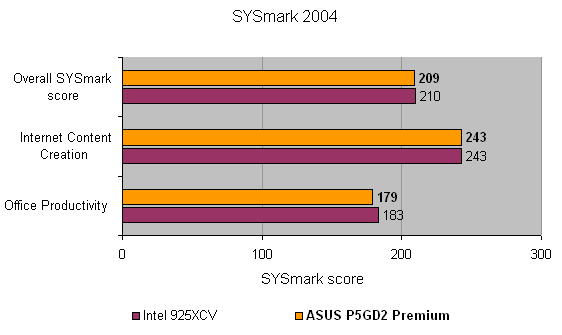
Verdict
Key Specifications
- Review Price: £152.00
ASUS has pulled out all the stops with the P5GD2 Premium Wireless Edition and I don’t think it’s possible to fit many more features to a motherboard than seen here. Just because the board is feature laden, doesn’t mean that ASUS has skimped on quality either and there are some unique solutions on this board that I have not come across before.
Most impressively the P5GD2 is completely passively cooled, so the only fan noise you will get is from the CPU cooler and any additional case fans. ASUS has even added a passive copper cooler on the MOSFETS, to aid the cooling of the power regulation. This is not unique, but it is a first for ASUS and it’s been done in a much more stylish way than the solutions I’ve seen from other manufacturers.
Asus has also added an extra PCB layer underneath the CPU socket, which is referred to as Stack Cool. It is supposed to lower the temperature of the area around the CPU by as much as 10 degrees Celsius, but this is very hard to prove. It does however seem to add extra rigidity to the PCB, which can’t be a bad thing considering how heavy the new CPU coolers are.
So, let’s take a closer look at what ASUS has managed to fit to the P5GD2 Premium Wireless Edition and what you can do with it. Being the first 915P motherboard that we have tested it was interesting to see how well it compared against the 925X chipset, as Intel once again claims that the superior model is meant to be a lot faster.
As the name implies, the board ships with wireless networking, thankfully of the faster 802.11g flavour – although this time around ASUS has fitted it to the motherboard itself, rather than supplying a card that attaches to a special connector.
The downside of hardwiring the WiFi adapter is that if it should fail, you would have to replace your entire motherboard, instead of a small add-in card. But you do gain a rear slot as a result, which could be important to users with fully stacked systems. The antenna supplied in the box comes with an 80cm cable, which allows you to place it on top of your case, or perhaps on your desk – although this might seem a bit messy, it will give you better range than an antenna attached to the back of the board.
ASUS supplies drivers that allow you to configure the wireless adapter as a wireless access point, rather than a network card, which means that you can share the wireless network connection with more than one PC at a time. This can be handy if you have more than one wireless device, but no wireless access point.
Continuing on the network theme, ASUS has added no less than two Gigabit Ethernet controllers to the P5GD2 Premium, both from Marvell, with the first one connecting to the PCI Express bus and the second to the PCI bus. This seems to have been done to cut cost, as the P5AD2 which is the 925X version of the P5GD2 features dual PCI Express networking. One can presume it was also done to make the P5AD2 more appealing over the cheaper P5GD2. The interesting thing here is that the PCI Gigabit controller connects to a rear bracket, something I have never come across on any motherboard in the past.
The same bracket is shared with two FireWire 1394b ports, which add support for 800Mbit FireWire. A second bracket adds a game port and two USB 2.0 ports. ASUS supplies a third bracket that gives you the option to attach SATA hard drives externally. This is a pass through connector that attaches to two of the eight internal SATA connectors and thus adds support for two external drives. It does also come with a special power adapter that gives you the option to attach an internal SATA drive outside of your case.
With eight SATA connectors and a rear bracket, ASUS has covered all possible configurations by supplying no less than 10 SATA cables as well as three SATA power adapters. You also get three IDE cables, as ASUS has managed to squeeze in an IDE RAID controller from ITE on top of the Silicon Image SATA RAID controller. There is of course support for Intel RAID as well via the ICH6R, so you can have two sets of four hard drives in RAID. Not counting the floppy drive, you can add no less than 14 drives to the P5GD2 Premium – home server anyone?
And we haven’t even got to the I/O panel, which consists of two PS/2 ports, a parallel port, optical and coaxial S/PDIF output, four USB 2.0 ports, a FireWire connector, the second Ethernet connector, discrete 7.1-channel audio outputs with a line in and microphone connector and finally the connector for the wireless networking antenna.
The P5GD2 Premium does of course come with Intel’s new High Definition audio and the codec is from C-Media and offers a wide range of features, including re-configurable audio jacks. This means that even if you plug something into the wrong socket, you can change the functionality of the audio socket in the sound drivers.
The layout of the slots is unusual, with the top slot being an x1 PCI Express slot and the second one down being the x16 PCI Express slot. Next to this is a gap, which means you won’t lose a slot if you have a graphics card with a big cooler on it. Below this are the two PCI slots and then a further two x1 PCI Express slots. ASUS has fitted four memory slots which support up to 4GB of PC4200 DDR2 SDRAM in dual channel configuration.
Apart from the four-pin CPU fan connector, there are a further three fan connectors spread around the board, although one is hidden between the memory slots and the ATX power connector – not an ideal position in my opinion. ASUS has placed one of the IDE connectors at an angle, making it easier to route cables inside the case. There is also a spare USB 2.0 header for those with a case that has front mounted USB ports.
I almost forgot to mention the serial port, as it comes on a bracket, but the physical connector on the motherboard seems to be in the wrong place as it is all the way up at the front of the motherboard. As long as you don’t make use of it you won’t have any issues with the cable routing, but that’s hardly ideal. That said, since the board is already cramped, there might not have been any other suitable location to fit the connector.
The only thing that seems to be missing is S/PDIF input, but this is only a minor complaint on an otherwise very well featured motherboard. ASUS supplies a copy of interVideo WinDVD Suite in the box, which consists of WinDVD 5, WinDVD Creator Platinum 2 and WinRip 2, it’s a shame that the copy of WinDVD 5 is only 5.1-channel, but it’s not a bad software bundle to get with a motherboard. A copy of PC-cillin 2002 is also thrown in for good measure, but this anti-virus software is getting a bit long in the tooth now.
The manual is well written and covers all of the features of the motherboard as well as the BIOS setup screens and some of the drivers and RAID utilities. It could however, do with some better instructions on how to install the motherboard and some colour pictures.
ASUS has also supplied a range of its own overclocking tweaks in the BIOS and the latest one is referred to as N.O.S which stands for Non-delay Overclocking System and allows your CPU to be instantly overclocked by up to 30% under load. Anyone into performance cars will know just why Asus has called its overclocking utility N.O.S. Other handy features include the built-in network cable tester, that will detect and report damaged network cables – this can be handy when trying to track down problems on your network.
In terms of performance there is no way I can fault the P5GD2 as it’s nearly as fast as the Intel 925XCV board based on the 925X chipset in SYSmark 2004 and PCMark 2004. The Asus even out performs the Intel board in some of the 3D tests.
The biggest downside of the ASUS P5GD2 Premium Wireless Edition is the high retail price of £152.39 – but you do have to remember that the amount of features you’re getting for that price is staggering. The P5GD2 also performs on a par with 925X based motherboards, so it really is worth every penny.
”’Verdict”’
The ASUS P5GD2 Premium Wireless Edition is a cutting edge, feature packed monster of a motherboard. The performance is superb and there are more bits in the box than you could possibly wish for. If you can swallow the high asking price, you’ll have a very high class motherboard in your PC.
(table:features)

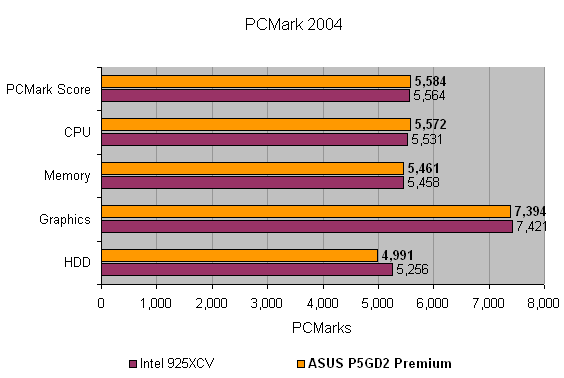
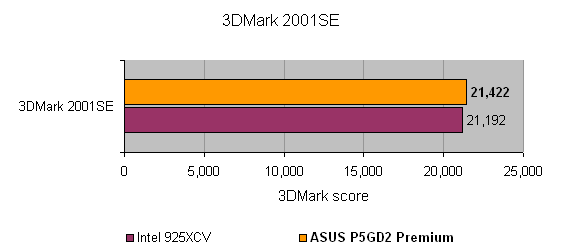
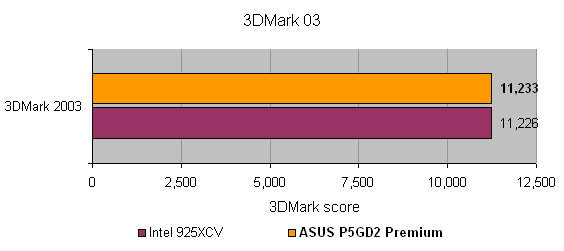
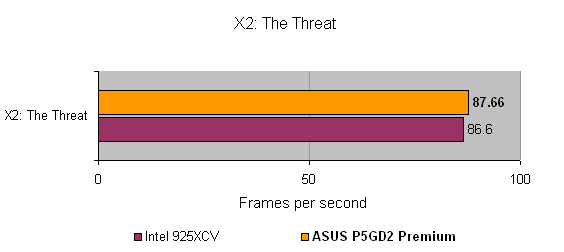
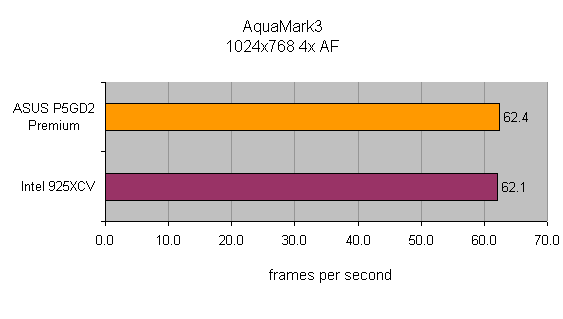
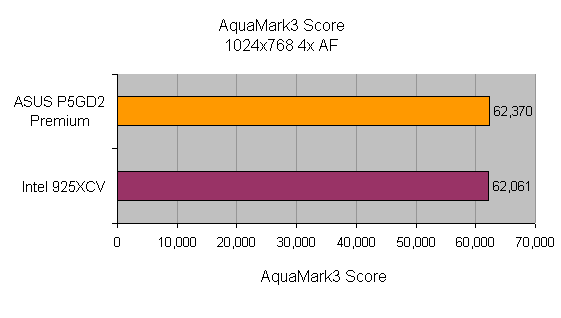
Trusted Score
Score in detail
-
Value 9
-
Performance 9

